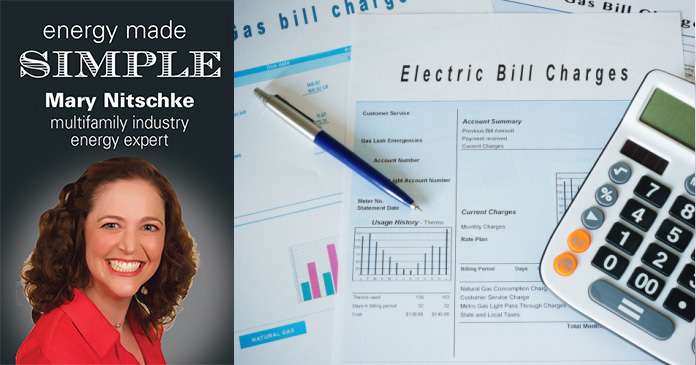
We have talked these past few weeks about the building and really looking at it in ways that might not have crossed our minds before. However, the million-dollar question when it comes to cutting energy costs is: what’s on the actual bill? As an industry, we don’t often really study the bill. Most of us have our bills on autopay. Either we are using a third party to process our utility bills, which is great, or we have an ACH set up with the utility provider so we don’t have to cut a bunch of checks (also great as that check stock is not cheap). The unfortunate thing about autopay when it comes to energy is that there could be very telling information on the utility bill, unrelated to the charges.
There are some quick things you can look at to see if you are being charged too much on your actual energy bill (and this applies to both gas and electricity).
- Rate: Look at what rate you are on. If the rate says “residential” and it is a common area account, chances are it was set up incorrectly. On more than one occasion, I have seen this issue on new construction. What sometimes happens with the rate classification on new construction is that the General Contractor applies to get meters for the property. When asked what type of property it is, even when getting a commercial load meter (which basically means a meter that can handle a LOT of energy), the General Contractor describes the property as “residential” since the building is going to supply housing to a bunch of people. The problem occurs when the utility provider associates “residential account” with a single-family home. The energy it takes to run an elevator, or a commercial grade domestic hot water system is VERY different than the amount of energy it takes to run a 2,000-sf home. A residential rate classification can sometimes be the kiss of death since high commercial consumption can put you into higher pricing tiers. I would make a call to the utility provider and ask for a rate audit (they do these for free) and sometimes the provider will even retroactively make the correction and refund you. This can save you hundreds of thousands of dollars, no exaggeration.
- Tax: If your property is in a market where tax should not be assessed on energy for multifamily property (you will know it if you are), look at your bills at least annually to ensure that there is no tax being assessed. Providers will sometimes refund you, but it can take a little gymnastics. If you don’t have the capacity to chase the providers for refunds and corrections, I recommend making your life a little easier by hiring a consultant to do this for you. Sure, these consultants typically take a percentage of whatever they recover, but you will still save thousands of dollars compared to doing nothing.
- Assume makes an Ass of “u” and “me.” If you mandate that your property managers are looking at the bills and doing #1 and #2 for you and have no checks to validate this is being done, see the previous sentence. Your managers are super busy. Residents yell at them all day. They are managing as much stuff with staff shortages as you are. If you know your team is drowning, and you yourself feel like you are stretched thin, hire a consultant on a shared savings program. Worst case, they look at the bills and find nothing. Best case, they save you thousands of dollars you didn’t know you were leaving on the table.














